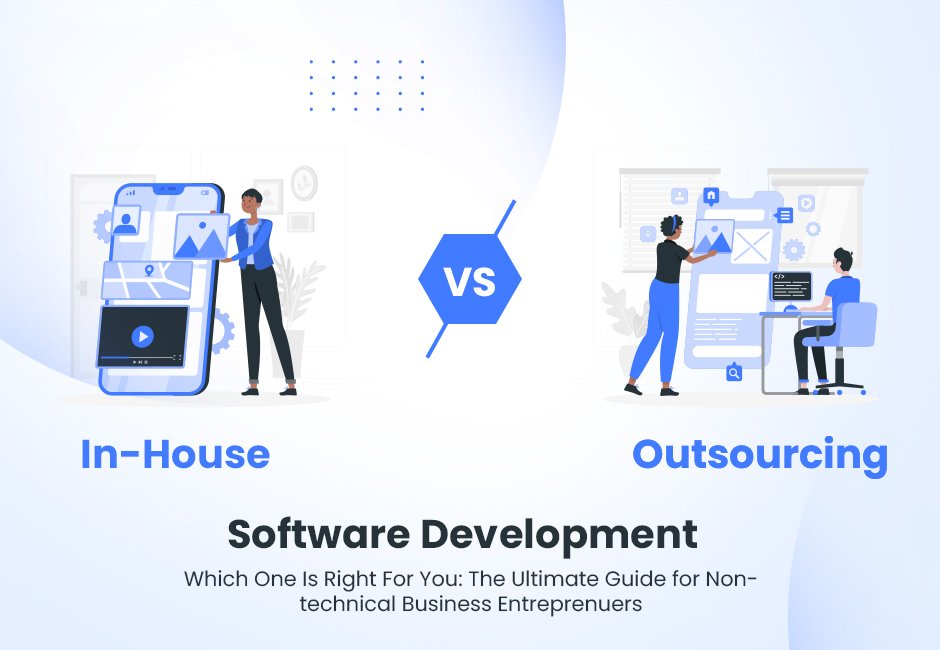A recent study revealed that app-based startups receive 825% higher initial public offerings than non-app-based startups. So, no wonder businesses across the industry rush to build a mobile app for their ventures. However, building a mobile app is a challenging choice for non-technical business founders as they often need help with the question of in-house vs. outsourcing software development: which one is best? Each option has its advantages and disadvantages, and simply put, the decision is a tough one. This decision is more than just a matter of cost—it’s about balancing control, expertise, flexibility, and speed to market.
Furthermore, it has a profound impact on ensuring the future success and growth of the business, making it crucial for a non-technical business founder to evaluate each aspect of these two approaches. In this article, we will explore the key factors influencing this critical choice, analyze the advantages and disadvantages of each option, and provide actionable insights to help you make this crucial choice. So, read the blog till the end.
Table of Contents
ToggleIn-House Vs. Outsourcing Software Development-Understanding your Option:
In-House Software Development: In-house mobile app development refers to the process of building and maintaining a mobile application using the organization’s own resources and developers team, designers, and tech professionals. The businesses directly employ these professionals and developers with the aim of having complete control over the development process. Incorporating this development method can help you ensure that the app closely aligns with the vision, culture, and specific requirements of your business.
Common Scenarios Where In-House Software Development Is Preferred:
- Sensitive Data Handling: Suppose you own a business that deals with susceptible data, such as financial institutions, healthcare providers, or data management agencies. In that case, having an in-house development team can help you maintain stringent security measures and ensure data confidentiality.
- Proprietary Technology: If you own innovative technology or intellectual property that requires protection from external threats and attacks, the best option is to have an in-house software development team.
- Complex Systems Integration: When your business already has an existing system and needs a new sophisticated application to integrate with it, you need an in-house software development team. In this scenario, your in-house software development team can be much more effective as they are familiar with the current infrastructure and can handle these complexities more efficiently.
- Sufficient Resources: If your startup has enough resources, you can use them to invest in developing software for your business. Furthermore, you are confident that the resources are enough to maintain an expert development team and can accomplish the long-term development needs of your newly developed application.
- Frequent Iterations and Customization: Companies needing frequent updates, customizations, or iterative changes throughout the development process benefit from the direct oversight and flexibility that in-house teams provide.
Outsourcing Software Development: Outsourcing software development involves hiring outside development firms or freelancers to manage and maintain all of your company’s software development projects. Hiring an external development agency can offer several advantages, particularly for non-technical entrepreneurs or businesses looking to optimize costs while building an app.
Common Scenarios Where Outsourcing Software Development Is Preferred:
- Limited Budget & Resources: If you are a startup owner with a limited budget, hiring an external software development team is the best option for you. This process allows you to access high-quality development services without the financial burden of maintaining a full-time in-house team. In addition, outsourcing helps manage costs by converting fixed costs into variable costs, allowing you to pay for services only when needed.
- Scalability & Flexibility: Businesses experiencing fluctuating workloads can leverage outsourcing to scale development efforts up or down quickly without the constraints of long-term employment contracts. For instance, if you have one-off projects or temporary initiatives, outsourcing provides the flexibility to hire a team for the project’s duration without ongoing commitments.
- Faster Time To Market: If your startup faces strict deadlines to launch products quickly, you can benefit from the rapid mobilization and dedicated resources of an outsourcing software development firm. Furthermore, you can leverage teams across different time zones, enabling you to have round-the-clock development that accelerates project timelines.
- Risk Mitigation: Outsourcing software development enables you to share project risks with your development partner, as external development agencies often have experience managing similar projects and mitigating common risks. Furthermore, due to high competition, reputable outsourcing development firms ensure high service quality and standards, reducing the risk of project failures.
- Tackling Talent Shortages: In regions with talent shortages or high competition for skilled developers, outsourcing offers a practical solution to access the necessary expertise without prolonged recruitment processes. Furthermore, by outsourcing a software development team, you can temporarily augment your team with specialized skills for specific projects.
In-House Vs. Outsourcing Software Development-Factors Affecting Your Choice
| Factor | In-House Development | Outsourced Development | Remarks |
| Cost Considerations | |||
| * Initial setup costs | High (office space, equipment, recruitment) | Low (minimal setup required) | In-house has a higher initial investment. |
| * Ongoing costs | Salaries, benefits, overhead | Project fees, potential additional costs | Ongoing costs for in-house can be predictable, while outsourced costs can vary depending on project scope. |
| Control and Flexibility | |||
| * Level of control over development process | High | Lower | In-house offers full control over every aspect. |
| * Flexibility in making changes | Moderate (depends on team size) | High (easier to adjust scope with outsourcing partner) | In-house flexibility can be limited by team size, while outsourcing is typically more adaptable. |
| Talent and Expertise | |||
| * Availability of skilled developers | Limited by your talent pool | Access to a wider range of expertise | Outsourcing offers access to a larger pool of developers. |
| * Access to specialized expertise | Requires hiring specialists | May be readily available from outsourcing partner | Outsourcing can provide access to specialized skills you might not have in-house. |
| Time to Market | |||
| * Speed of development | Can be fast with a well-established team | Can be fast if the outsourcing partner has relevant experience | Both can be fast, but in-house might have an edge if the team already understands your business. |
| * Meeting deadlines | Reliant on internal team performance | Reliant on clear communication and managing the outsourcing partner | Careful planning and communication are crucial for meeting deadlines in both cases. |
| Scalability | |||
| * Ability to scale team up or down | Time-consuming (recruitment, training) | Easier to scale quickly | Outsourcing allows for easier scaling based on project needs. |
| * Handling project changes | Can be slow depending on internal approvals | Generally faster to adapt due to outsourcing partner’s flexibility | Outsourcing is often more adaptable to changes. |
| Communication and Collaboration | |||
| * Ease of communication with the team | Easier due to physical proximity (for in-house) | Requires strong communication planning and tools | In-house has an advantage in casual communication, but good planning can overcome this with outsourcing. |
| * Tools and processes for collaboration | Requires investment in collaboration tools | May already be established with the outsourcing partner | The onus of setting up collaboration tools falls more on the in-house team. |
Advantages & Disadvantages Of In-House Software Development:
Advantages:
- Control and Customization:
- Direct Oversight: Full control over the development process allows for real-time adjustments and deeper customization.
- Immediate Changes: Ability to make quick changes based on feedback or shifting business needs.
- Team Integration:
- Cultural Fit: In-house teams align more closely with the company’s culture and goals.
- Clear Communication: Easier communication and collaboration with team members who are physically present or deeply integrated into the company.
- Quality Assurance:
- Consistent Standards: Maintaining high quality through direct supervision and established internal processes.
- Immediate Feedback: Quick iterations based on immediate feedback from stakeholders.
- Security:
- Data Protection: Better control over security measures and protection of sensitive data and intellectual property.
- Reduced Risk of Breaches: Lower risk of data breaches compared to sharing information with external vendors.
Disadvantages:
- Challenge of Scaling an In-house Team:
- Resource Limitations: Scaling an in-house team quickly to meet project demands can be difficult and time-consuming.
- Flexibility Issues: Less flexibility to ramp up or down based on project needs compared to outsourcing.
- Lacks Specialized Skill Sets:
- Limited Expertise: In-house teams may need more specialized skills for specific projects, requiring additional training or hiring.
- Skill Gaps: Need ongoing investment in training and development in order to keep up with the latest technologies and trends.
- Resource Allocation:
- Talent Acquisition: Challenges in finding and hiring the right talent, particularly in competitive markets.
- Scalability Issues: Difficulty in scaling the team up or down quickly based on project needs.
- Longer Time to Market:
- Onboarding: Time-consuming recruitment and onboarding processes.
- Limited Flexibility: Less flexibility in ramping up resources quickly for urgent projects.
Advantages & Disadvantages Of Outsourcing Software Development:
Advantages:
- Access to Global Talent:
- Specialized Skills: Access to a broad pool of specialized skills and expertise not available in-house.
- Highly Qualified Specialists: Ability to tap into a global network of highly qualified and experienced developers.
- Scalability and Flexibility:
- Rapid Project Expansion: Ability to scale resources up or down quickly based on project needs.
- Flexible Contracts: Engage teams on a project basis, allowing for flexibility in resource allocation.
- Faster Time to Market:
- Immediate Start: Ready-to-deploy teams that can start working on the project immediately.
- Round-the-Clock Development: Utilizing teams in different time zones for continuous development.
- Focus on Core Business:
- Delegation: Allows the internal team to focus on core business activities by delegating non-core tasks.
- Management Efficiency: Reduces the burden of managing a large in-house development team.
- Advanced Tools and Technologies:
- State-of-the-Art Resources: Outsourcing partners often invest in the latest tools, technologies, and infrastructure, which might be cost-prohibitive for individual companies to acquire.
- Technological Upgradation: Keeping pace with technological advancements without significant capital investment becomes feasible through outsourcing.
Disadvantages:
- Communication Challenges:
- Time Zone Differences: Potential delays and coordination issues due to different time zones.
- Language Barriers: Misunderstandings and miscommunications due to language differences.
- Control and Oversight:
- Less Direct Control: Reduced oversight and control over the development process.
- Dependency on Vendor: Risk of becoming too dependent on the outsourcing partner for critical functions.
- Quality Concerns:
- Variable Quality: Inconsistent quality standards across different vendors.
- Security Risks: Potential risks associated with sharing sensitive data and intellectual property with external parties.
- Cultural and Organizational Differences:
- Cultural Misalignment: Differences in work culture and practices that may affect collaboration.
- Integration Issues: Challenges in integrating outsourced work with internal processes and systems.
In-House vs. Outsourced Software Development: Weighing the Options:
As you can see, the choice between in-house vs. outsourced software development depends on your company’s specific requirements and resources. However, data around the world shows that for the last couple of years. More companies opt to hire outsourced software specialists to manage IT-related projects. Recent data indicates that the IT outsourcing market is expected to reach US$541.10 billion in 2024 and is projected to grow at a CAGR of 8.48% over the next five years, reaching US$812.70 billion by 2029. The United States is expected to be the top revenue-generating region in 2024, with US$197.30 billion in revenue. The average spend per employee in the IT outsourcing market is also projected to reach US$152.00 in 2024.
The application outsourcing market is experiencing steady growth and is projected to reach $129.90 billion by 2028 at a CAGR of 1.84%. It indicates a rising preference for leveraging external expertise. Additionally, the average spend per employee in application outsourcing will sit at $34.08 in 2023, highlighting the significant investments companies are making in these external resources. These statistics suggest that businesses are increasingly recognizing the cost-effectiveness and flexibility offered by outsourcing.
The Final Verdict- In-House Vs. Outsourcing Software Development: Which Option Is Best For Non-Technical Business Founders Like You:
As you can see, there’s no one-size-fits-all answer to the in-house vs. outsourcing software development debate. The best approach depends on your specific project and company needs. Consider the factors listed above carefully to make an informed decision.
Now, let’s see which option is preferable for a non-technical founder like you.
| Factor | In-House Development | Outsourced Development | Verdict |
| Company Size | Large Enterprise | Small/Medium Business, Startup | Outsourcing is often more cost-effective for smaller companies. In-house development becomes viable as a company scales. |
| Budget | High Budget | Tight Budget | Outsourcing offers flexibility and can be more economical for projects with limited budgets. |
| Technical Knowledge | Strong Internal Development Expertise | Limited Technical Knowledge | Outsourcing provides access to a wider talent pool and reduces the burden of managing a development team. |
| Future Expansion Plans | Long-Term Investment Required | Scalable and Adaptable | Outsourcing allows you to scale the team up or down as needed, aligning well with expansion plans. |
| Number of Projects | Multiple Ongoing Projects | Single Project or Short-Term Needs | Outsourcing can be ideal for handling multiple projects without inflating fixed costs. Consider in-house if managing a dedicated team for ongoing projects is feasible. |
| Industry | Highly Specialized Industry | General Industry | If your industry requires niche expertise, outsourcing might offer access to specialized developers. However, in-house development can be suitable for general industry needs. |
Outsourcing is generally a good option for non-technical founders like you, especially for startups and small businesses. It offers cost-effectiveness, scalability, and access to a broader talent pool. However, in-house software development can be a better fit for large enterprises with a solid technical team and long-term software development needs.
Checklist For Outsourcing Software Development:
Selection of Outsourcing Partner:
- Define Requirements:
- Clearly outline the project scope and technical requirements.
- Identify necessary skills and expertise.
- Research Potential Partners:
- Check the reputation and portfolio of potential vendors.
- Look for client testimonials and case studies.
- Evaluate Capabilities:
- Assess technical knowledge and experience in similar projects.
- Verify the availability of necessary resources and infrastructure.
- Conduct Interviews:
- Interview key team members to gauge their competency and communication skills.
- Evaluate cultural and operational fit.
- Request Proposals:
- Solicit detailed proposals, including timelines, costs, and methodologies.
- Compare proposals based on set criteria.
Project Initiation & Planning:
- Define Objectives:
- Clearly state project goals and deliverables.
- Set realistic timelines and milestones.
- Establish Communication Channels:
- Set up regular communication protocols and tools (e.g., Slack, Zoom).
- Define roles and responsibilities.
- Sign Contracts:
- Draft and sign detailed contracts covering scope, timelines, costs, and deliverables.
- Include confidentiality agreements and intellectual property rights.
Development Phase:
- Kick-off Meeting:
- Conduct a project kick-off meeting to align expectations and clarify details.
- Set Up Project Management Tools:
- Utilize tools like Jira, Trello, or Asana for task management and tracking.
- Regular Updates:
- Schedule regular updates and progress reports.
- Monitor adherence to timelines and milestones.
Testing & Quality Assurance:
- Develop Testing Plan:
- Outline testing strategies, including unit, integration, and user acceptance testing.
- Define success criteria and metrics.
- Conduct Regular Testing:
- Perform iterative testing throughout the development process.
- Log and address bugs and issues promptly.
- User Acceptance Testing:
- Engage end-users in testing to validate functionality and usability.
- Gather feedback and implement necessary changes.
Documentation & Knowledge Transfer:
- Maintain Comprehensive Documentation:
- Ensure all code, processes, and decisions are well-documented.
- Include user manuals and technical specifications.
- Facilitate Knowledge Transfer:
- Arrange sessions for the internal team to learn about the system.
- Provide necessary training materials and resources.
Security & Compliance:
- Data Security Measures:
- Implement data protection protocols and encryption.
- Ensure compliance with relevant data privacy regulations (e.g., GDPR, HIPAA).
- Access Controls:
- Define and enforce access control policies.
- Regularly review and update security measures.
- Risk Management:
- Identify potential risks and mitigation strategies.
- Perform regular security audits and assessments.
Deployment & Transition:
- Develop Deployment Plan:
- Outline steps for deploying the software in the production environment.
- Prepare rollback plans in case of issues.
- User Training:
- Provide training sessions for end-users.
- Create user guides and support resources.
- Monitor Initial Deployment:
- Closely monitor the system post-deployment for any problems.
- Gather user feedback and make necessary adjustments.
Project Closure & Evaluation:
- Final Review:
- Conduct a thorough review of the project against initial objectives.
- Document lessons learned and best practices.
- Client Satisfaction:
- Gather feedback from all stakeholders on the project outcome.
- Address any remaining concerns or issues.
- Closure Report:
- Prepare a detailed project closure report summarizing achievements, challenges, and outcomes.
- Archive all project documents and materials for future reference.
Why Choose Logic Square Technologies For Software Development Outsourcing:
In-house vs. outsourcing software development is a never-ending debate, but if you are a non-technical startup owner, outsourcing your IT services to Logic Square Technologies can be the best decision you can take. Choosing Logic Square Technologies means partnering with a team dedicated to delivering exceptional results through our lean MVP model, sharp talent pool, and frugal innovations. Our collaborative web and development process ensures that every project, from ideation and conceptualization to launch and deployment, is managed seamlessly and efficiently. Our lean MVP model allows us to rapidly prototype and test ideas, ensuring that your product reaches the market faster with the most crucial features intact.
With a team of highly skilled professionals, we bring a wealth of expertise and innovative thinking to every project, ensuring high-quality outcomes that are both robust and scalable. Additionally, our focus on frugal innovation helps maximize value while keeping costs in check, making us the perfect choice for cost-effective software development without compromising on quality. Partner with Logic Square Technologies and experience the assurance of top-notch software development that meets your business needs and budget constraints.
FAQs:
- What are the key factors to consider when deciding between in-house and outsourced software development?
- Project Scope and Requirements: Define the specific needs and goals of your project.
- Budget: Assess the financial resources available for development.
- Timeline: Consider the urgency of your project and the time required to build an in-house team versus outsourcing.
- Control and Oversight: Determine how much direct control you need over the development process.
- Talent and Expertise: Evaluate the availability of necessary skills within your organization versus external providers.
2. What are the advantages of in-house software development?
- Direct Control: Greater oversight and immediate adjustments during the development process.
- Team Integration: Alignment with company culture and seamless communication.
- Quality Assurance: Consistent standards maintained through internal processes.
- Data Security: Enhanced control over security measures and sensitive data protection.
3. What are the disadvantages of in-house software development?
- Scaling Challenges: Difficulty in rapidly scaling the team for project needs.
- Skill Gaps: Limited access to specialized skills without additional training or hiring.
- Longer Time to Market: Lengthy recruitment and onboarding processes.
4. What are the advantages of outsourcing software development?
- Cost Efficiency: Lower labor costs and reduced overhead expenses.
- Access to Global Talent: Availability of specialized skills and expertise.
- Scalability and Flexibility: Ability to quickly scale resources based on project demands.
- Faster Time to Market: Ready-to-deploy teams and continuous development capabilities.
- Highly Qualified Specialists: Expertise in the latest technologies and best practices.
5. What are the disadvantages of outsourcing software development?
- Communication Challenges: Potential delays and misunderstandings due to time zones and language differences.
- Control and Oversight: Reduced direct control over the development process.
- Quality Concerns: Variability in quality standards across different vendors.
- Security Risks: Potential risks associated with sharing sensitive data with external parties.
6. When is it best to opt for in-house software development?
- Long-term Projects: Projects requiring ongoing development and maintenance.
- High-Security Needs: Projects involving sensitive data and stringent security requirements.
- Close Collaboration: Projects needing tight integration with internal processes and frequent stakeholder interaction.
7. When is the best time to outsource software development?
- Short-term or One-off Projects: Projects with transparent, defined scopes and shorter timelines.
- Specialized Skills: Projects requiring expertise that is not available in-house.
- Rapid Scaling: When rapid project expansion and resource flexibility are needed.
8. What should be included in a comprehensive checklist before outsourcing software development?
- Selection of Outsourcing Partner: Define requirements, research potential partners, evaluate capabilities, conduct interviews, request proposals, and check references.
- Project Initiation & Planning: Define objectives, establish communication channels, and sign contracts.
- Development Phase: Conduct kick-off meetings, set up project management tools, and schedule regular updates.
- Testing & Quality Assurance: Develop a testing plan, conduct regular testing, and perform user acceptance testing.
- Documentation & Knowledge Transfer: Maintain comprehensive documentation and facilitate knowledge transfer.
- Security & Compliance: Implement data security measures, enforce access controls, and manage risks.
- Deployment & Transition: Develop a deployment plan, provide user training, and monitor initial deployment.
- Project Closure & Evaluation: Conduct a final review, gather client feedback, and prepare a closure report.
9. How does Logic Square Technologies ensure quality and cost-effectiveness in software development?
- Lean MVP Model: Rapid prototyping and testing to bring products to market faster.
- Sharp Talent Pool: Highly skilled professionals with extensive expertise.
- Frugal Innovations: Maximizing value while keeping costs in check.
- Collaborative Process: Seamless management of projects from ideation to deployment.





